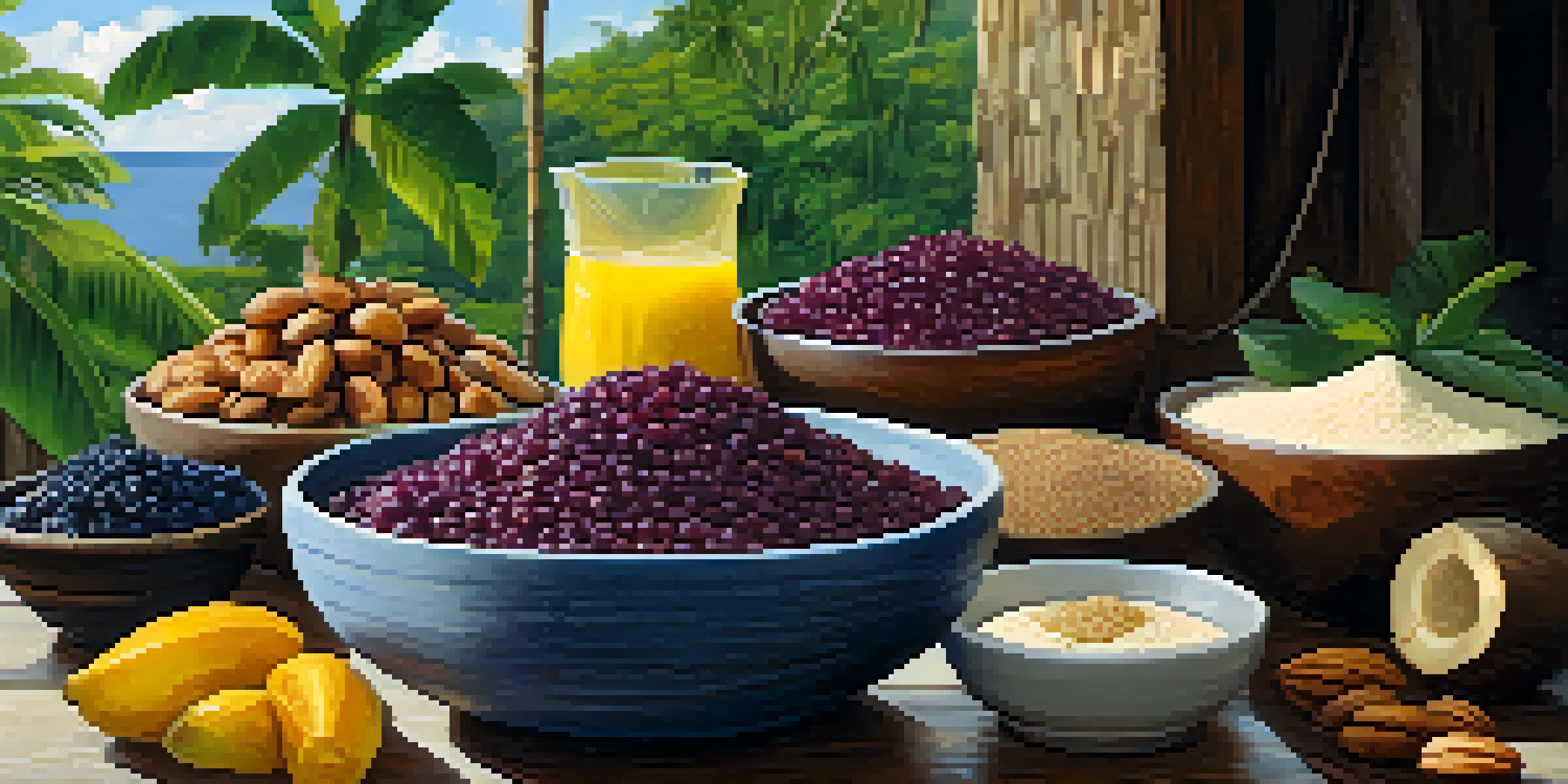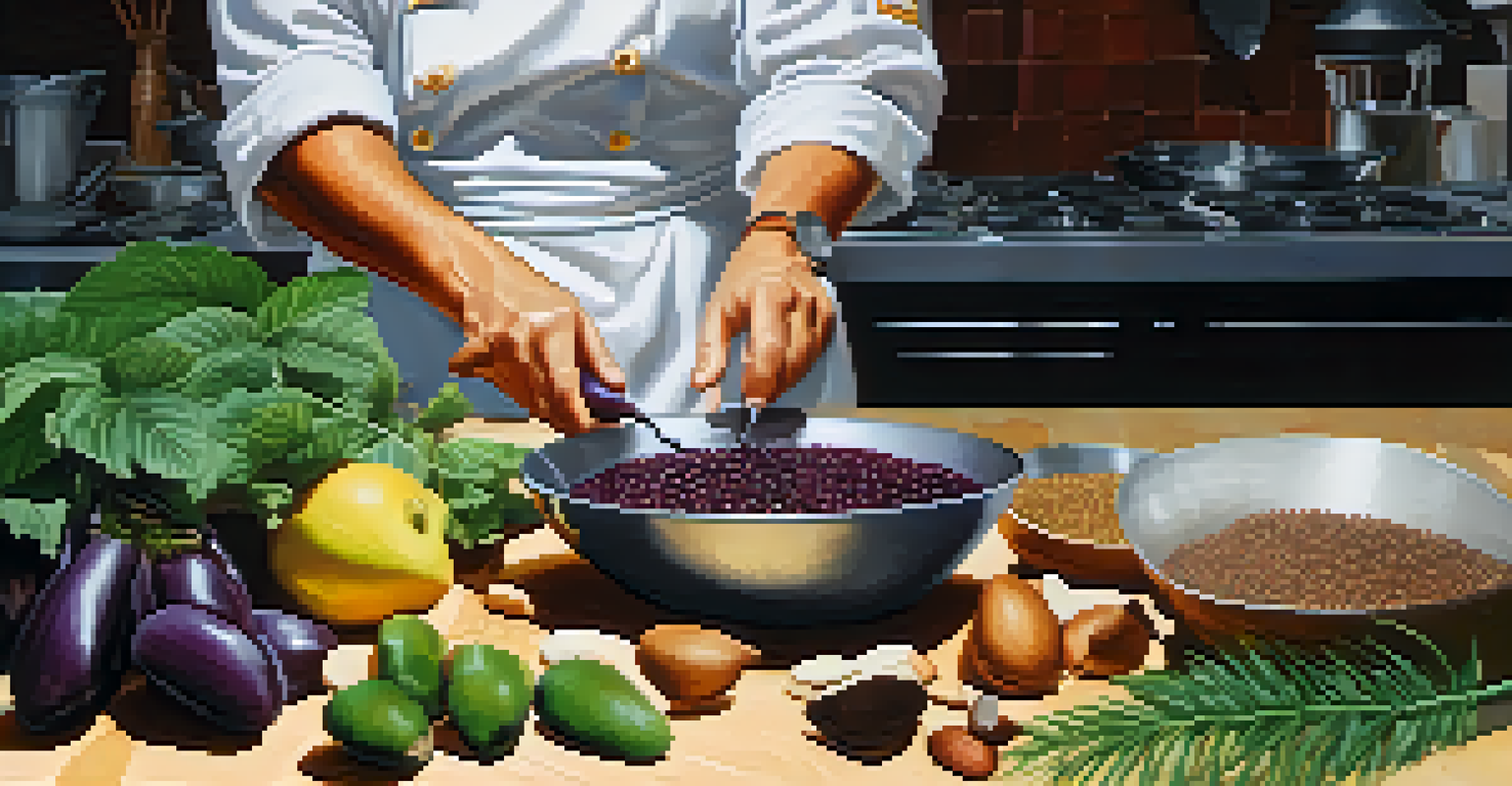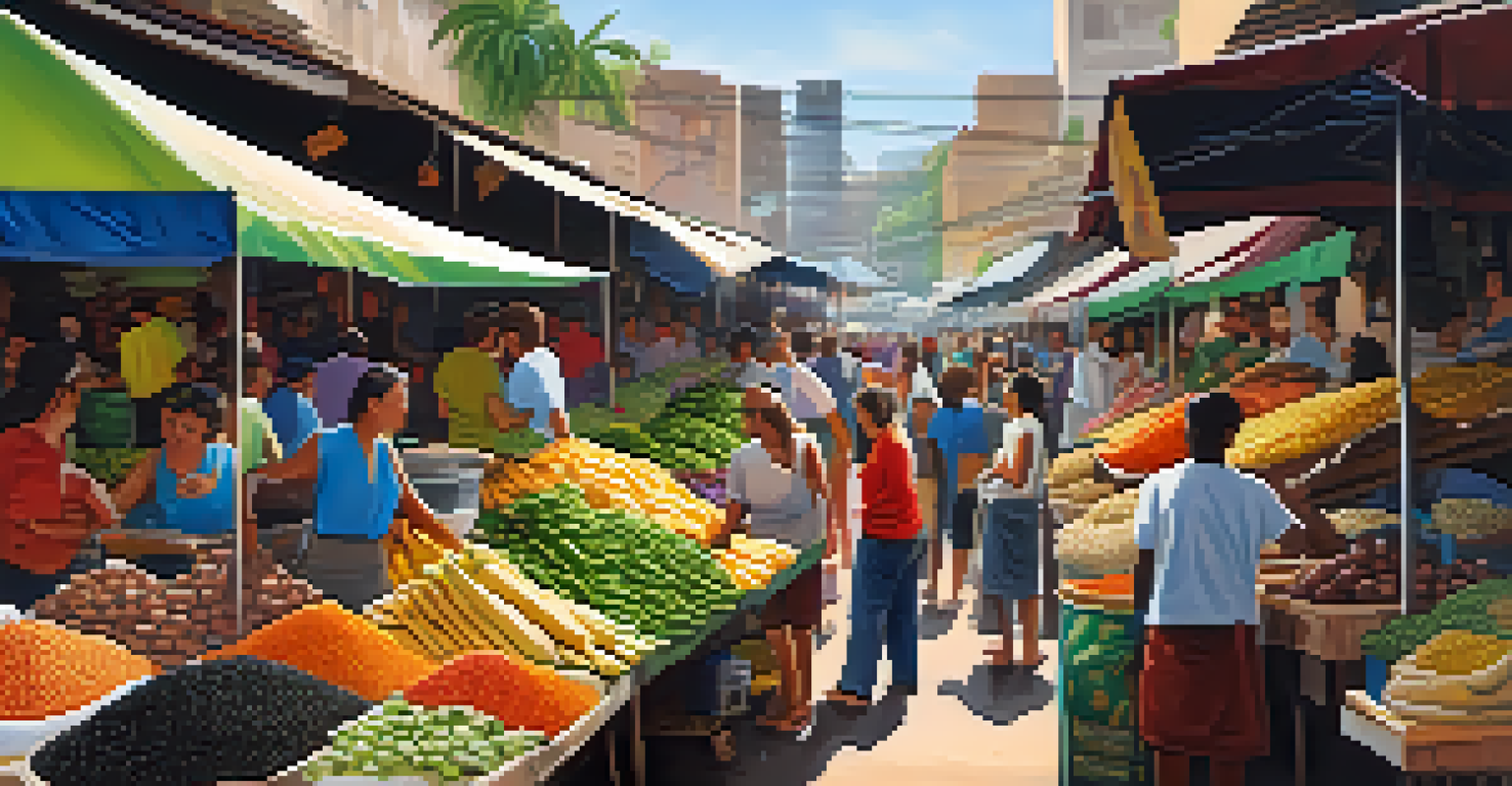The Role of Amazonian Ingredients in Brazil's Food Culture

The Amazon Rainforest: A Culinary Treasure Trove
The Amazon Rainforest is often celebrated for its biodiversity, but it's also a treasure trove of culinary ingredients. With over 30,000 plant species, many of these ingredients are essential to Brazil’s food culture. From fruits to herbs, the Amazon provides unique flavors that are deeply ingrained in local cuisines.
The Amazon is a place where the magic of nature and the richness of culture intertwine.
Incorporating Amazonian ingredients into dishes not only enhances flavor but also showcases the region's rich cultural heritage. Ingredients like açaí and cupuaçu are not just popular; they are emblematic of Amazonian identity. They reflect the connection between the land and the people, creating a narrative that goes beyond simple nourishment.
Moreover, the use of these ingredients promotes sustainability. By utilizing what the Amazon offers, chefs and home cooks alike contribute to a cycle that respects and preserves the environment. This relationship between food and nature is a vital part of Brazil's culinary ethos.
Key Amazonian Ingredients and Their Uses
Some of the most notable Amazonian ingredients include açaí, manioc, and Brazil nuts, each with unique properties and culinary uses. Açaí, often enjoyed as a smoothie bowl or in desserts, is packed with antioxidants and is a staple in many Brazilian diets. Manioc, or cassava, is used to make farinha, a common side dish that complements various meals.

Brazil nuts, rich in selenium, are not only a nutritious snack but also add a delightful crunch to salads and desserts. The versatility of these ingredients allows chefs to experiment and innovate, leading to exciting new dishes that celebrate Amazonian flavors. This creativity keeps traditional Brazilian cuisine alive while also evolving.
Amazon's Culinary Diversity Shines
The Amazon Rainforest offers a wealth of unique ingredients that are integral to Brazil's rich food culture.
As the demand for exotic ingredients grows globally, these Amazonian staples are gaining popularity outside Brazil. Restaurants around the world are starting to showcase these ingredients, creating a fusion of flavors that celebrates the Amazon's unique culinary contributions. This trend helps to elevate Brazil's food culture on an international stage.
The Cultural Significance of Amazonian Ingredients
In Brazilian culture, food is more than just sustenance; it's a way to connect with one's roots and community. Many Amazonian ingredients are tied to indigenous practices and traditions, making them integral to Brazil's cultural identity. For example, the preparation of dishes using these ingredients often involves communal cooking, fostering bonds among family and friends.
Food is not just what we eat; it's a reflection of who we are and where we come from.
Indigenous knowledge regarding these ingredients is passed down through generations, enriching the culinary landscape. This knowledge encompasses not only the preparation of food but also the sustainable harvesting of ingredients, ensuring that traditional practices are respected. Thus, food becomes a medium for cultural preservation.
Furthermore, as more Brazilians embrace their heritage, there is a renewed interest in traditional cooking methods that highlight Amazonian ingredients. This revival not only strengthens community ties but also promotes a deeper understanding of Brazil's diverse cultural tapestry. It’s a beautiful reminder that food serves as a bridge between past and present.
Sustainable Practices in Using Amazonian Ingredients
Sustainability plays a crucial role in the culinary landscape of Brazil, particularly regarding Amazonian ingredients. Many chefs are committed to sourcing their ingredients ethically, ensuring that they do not contribute to deforestation or environmental degradation. This commitment is reflected in the use of wild-harvested ingredients that support local communities.
By prioritizing sustainable practices, Brazil's culinary scene not only preserves the Amazon but also empowers local populations. Many indigenous communities rely on the harvesting of these ingredients for their livelihoods, making it essential to uphold these sustainable practices. This creates a win-win situation where biodiversity is protected, and local economies thrive.
Sustainability is Key in Cuisine
Chefs focus on ethically sourcing Amazonian ingredients, promoting sustainable practices that benefit both the environment and local communities.
Additionally, the rise of eco-tourism has encouraged more people to learn about Amazonian ingredients and their sustainable use. Culinary tours often highlight the importance of ethical sourcing, allowing participants to appreciate the flavors while understanding the environmental impact. This awareness fosters a greater appreciation for the Amazon's role in Brazil's food culture.
Modern Interpretations of Amazonian Cuisine
While traditional Amazonian dishes are cherished, modern chefs are finding innovative ways to reinterpret these flavors. By blending traditional ingredients with contemporary cooking techniques, they create dishes that appeal to a broader audience. This fusion not only tantalizes taste buds but also sparks curiosity about Brazil's culinary roots.
For instance, chefs may incorporate açaí into gourmet desserts or use Brazil nuts in unconventional ways, like in savory sauces. This creativity showcases the adaptability of Amazonian ingredients, highlighting their versatility beyond traditional recipes. Such adaptations invite diners to explore the complexities of Brazilian cuisine.
Moreover, these modern interpretations often celebrate local ingredients while promoting sustainability. Chefs are increasingly focusing on seasonal and locally sourced Amazonian ingredients, ensuring that their dishes are environmentally conscious. This approach resonates with diners who are looking for meaningful dining experiences that connect them to the food they consume.
Amazonian Ingredients in Brazil's Urban Centers
In recent years, urban centers in Brazil have become hubs for showcasing Amazonian ingredients. Restaurants in cities like São Paulo and Rio de Janeiro are leading the charge, incorporating these unique flavors into their menus. This trend not only highlights the diversity of Brazilian cuisine but also makes Amazonian ingredients more accessible to a wider audience.
Urban markets and food festivals often feature Amazonian products, allowing consumers to explore and purchase these ingredients directly. This direct connection helps consumers understand the origins of their food and fosters a greater appreciation for the Amazon's bounty. It also empowers local farmers and producers, creating a sustainable market.
Modern Takes on Traditional Flavors
Innovative chefs are reinterpreting Amazonian ingredients, blending them with contemporary techniques to create exciting new dishes.
As more people in cities embrace Amazonian cuisine, there is a growing sense of pride in Brazilian culinary heritage. Chefs and food enthusiasts alike are eager to share their knowledge, leading to workshops and cooking classes that educate others about these precious ingredients. This exchange of knowledge not only enriches the culinary community but also strengthens the bond between urban and rural Brazil.
The Future of Amazonian Ingredients in Brazil's Culinary Scene
Looking ahead, the future of Amazonian ingredients in Brazil's culinary scene appears promising. As awareness of sustainable practices and indigenous traditions grows, more chefs are likely to focus on these ingredients. This shift could lead to a culinary renaissance that celebrates the richness of the Amazon while respecting its ecosystems.
Additionally, the global interest in plant-based diets and exotic flavors presents an opportunity for Amazonian ingredients to shine on the world stage. As more people seek to incorporate healthier, sustainable options into their diets, these ingredients can play a pivotal role. This trend may inspire international chefs to experiment with Amazonian flavors, further elevating Brazil's culinary reputation.

In conclusion, the future of Amazonian ingredients is tied to a broader understanding of sustainability, culture, and innovation. As Brazil continues to explore and celebrate its culinary heritage, the Amazon will undoubtedly remain at the heart of this vibrant food culture. Embracing these ingredients is not just about flavor; it's about honoring the land and its people.